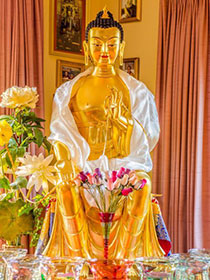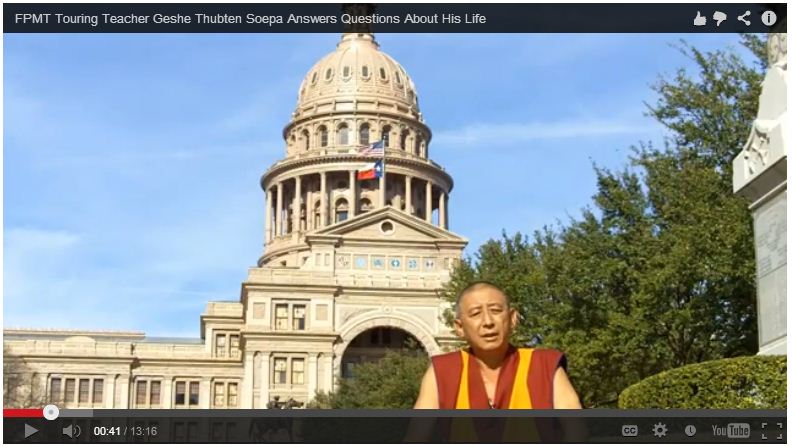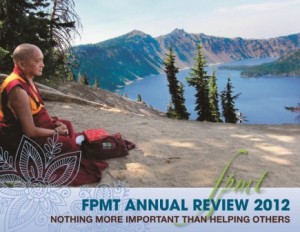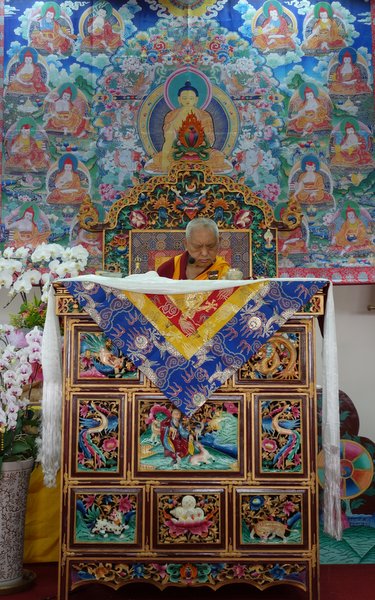- Home
- FPMT Homepage
Foundation for the Preservation of the Mahayana Tradition
The FPMT is an organization devoted to preserving and spreading Mahayana Buddhism worldwide by creating opportunities to listen, reflect, meditate, practice and actualize the unmistaken teachings of the Buddha and based on that experience spreading the Dharma to sentient beings. We provide integrated education through which people’s minds and hearts can be transformed into their highest potential for the benefit of others, inspired by an attitude of universal responsibility and service. We are committed to creating harmonious environments and helping all beings develop their full potential of infinite wisdom and compassion. Our organization is based on the Buddhist tradition of Lama Tsongkhapa of Tibet as taught to us by our founders Lama Thubten Yeshe and Lama Thubten Zopa Rinpoche.
- Willkommen
Die Stiftung zur Erhaltung der Mahayana Tradition (FPMT) ist eine Organisation, die sich weltweit für die Erhaltung und Verbreitung des Mahayana-Buddhismus einsetzt, indem sie Möglichkeiten schafft, den makellosen Lehren des Buddha zuzuhören, über sie zur reflektieren und zu meditieren und auf der Grundlage dieser Erfahrung das Dharma unter den Lebewesen zu verbreiten.
Wir bieten integrierte Schulungswege an, durch denen der Geist und das Herz der Menschen in ihr höchstes Potential verwandelt werden zum Wohl der anderen – inspiriert durch eine Haltung der universellen Verantwortung und dem Wunsch zu dienen. Wir haben uns verpflichtet, harmonische Umgebungen zu schaffen und allen Wesen zu helfen, ihr volles Potenzial unendlicher Weisheit und grenzenlosen Mitgefühls zu verwirklichen.
Unsere Organisation basiert auf der buddhistischen Tradition von Lama Tsongkhapa von Tibet, so wie sie uns von unseren Gründern Lama Thubten Yeshe und Lama Thubten Zopa Rinpoche gelehrt wird.
- Bienvenidos
La Fundación para la preservación de la tradición Mahayana (FPMT) es una organización que se dedica a preservar y difundir el budismo Mahayana en todo el mundo, creando oportunidades para escuchar, reflexionar, meditar, practicar y actualizar las enseñanzas inconfundibles de Buda y en base a esa experiencia difundir el Dharma a los seres.
Proporcionamos una educación integrada a través de la cual las mentes y los corazones de las personas se pueden transformar en su mayor potencial para el beneficio de los demás, inspirados por una actitud de responsabilidad y servicio universales. Estamos comprometidos a crear ambientes armoniosos y ayudar a todos los seres a desarrollar todo su potencial de infinita sabiduría y compasión.
Nuestra organización se basa en la tradición budista de Lama Tsongkhapa del Tíbet como nos lo enseñaron nuestros fundadores Lama Thubten Yeshe y Lama Zopa Rinpoche.
A continuación puede ver una lista de los centros y sus páginas web en su lengua preferida.
- Bienvenue
L’organisation de la FPMT a pour vocation la préservation et la diffusion du bouddhisme du mahayana dans le monde entier. Elle offre l’opportunité d’écouter, de réfléchir, de méditer, de pratiquer et de réaliser les enseignements excellents du Bouddha, pour ensuite transmettre le Dharma à tous les êtres. Nous proposons une formation intégrée grâce à laquelle le cœur et l’esprit de chacun peuvent accomplir leur potentiel le plus élevé pour le bien d’autrui, inspirés par le sens du service et une responsabilité universelle. Nous nous engageons à créer un environnement harmonieux et à aider tous les êtres à épanouir leur potentiel illimité de compassion et de sagesse. Notre organisation s’appuie sur la tradition guéloukpa de Lama Tsongkhapa du Tibet, telle qu’elle a été enseignée par nos fondateurs Lama Thoubtèn Yéshé et Lama Zopa Rinpoché.
Visitez le site de notre Editions Mahayana pour les traductions, conseils et nouvelles du Bureau international en français.
Voici une liste de centres et de leurs sites dans votre langue préférée
- Benvenuto
L’FPMT è un organizzazione il cui scopo è preservare e diffondere il Buddhismo Mahayana nel mondo, creando occasioni di ascolto, riflessione, meditazione e pratica dei perfetti insegnamenti del Buddha, al fine di attualizzare e diffondere il Dharma fra tutti gli esseri senzienti.
Offriamo un’educazione integrata, che può trasformare la mente e i cuori delle persone nel loro massimo potenziale, per il beneficio di tutti gli esseri, ispirati da un’attitudine di responsabilità universale e di servizio.
Il nostro obiettivo è quello di creare contesti armoniosi e aiutare tutti gli esseri a sviluppare in modo completo le proprie potenzialità di infinita saggezza e compassione.
La nostra organizzazione si basa sulla tradizione buddhista di Lama Tsongkhapa del Tibet, così come ci è stata insegnata dai nostri fondatori Lama Thubten Yeshe e Lama Zopa Rinpoche.
Di seguito potete trovare un elenco dei centri e dei loro siti nella lingua da voi prescelta.
- 欢迎 / 歡迎
简体中文
“护持大乘法脉基金会”( 英文简称:FPMT。全名:Foundation for the Preservation of the Mahayana Tradition) 是一个致力于护持和弘扬大乘佛法的国际佛教组织。我们提供听闻,思维,禅修,修行和实证佛陀无误教法的机会,以便让一切众生都能够享受佛法的指引和滋润。
我们全力创造和谐融洽的环境, 为人们提供解行并重的完整佛法教育,以便启发内在的环宇悲心及责任心,并开发内心所蕴藏的巨大潜能 — 无限的智慧与悲心 — 以便利益和服务一切有情。
FPMT的创办人是图腾耶喜喇嘛和喇嘛梭巴仁波切。我们所修习的是由两位上师所教导的,西藏喀巴大师的佛法传承。
繁體中文
護持大乘法脈基金會”( 英文簡稱:FPMT。全名:Found
ation for the Preservation of the Mahayana Tradition ) 是一個致力於護持和弘揚大乘佛法的國際佛教組織。我們提供聽聞, 思維,禪修,修行和實證佛陀無誤教法的機會,以便讓一切眾生都能 夠享受佛法的指引和滋潤。 我們全力創造和諧融洽的環境,
為人們提供解行並重的完整佛法教育,以便啟發內在的環宇悲心及責 任心,並開發內心所蘊藏的巨大潛能 — 無限的智慧與悲心 – – 以便利益和服務一切有情。 FPMT的創辦人是圖騰耶喜喇嘛和喇嘛梭巴仁波切。
我們所修習的是由兩位上師所教導的,西藏喀巴大師的佛法傳承。 察看道场信息:
- FPMT Homepage
- News/Media
-
- Study & Practice
-
-
- About FPMT Education Services
- Latest News
- Programs
- New to Buddhism?
- Buddhist Mind Science: Activating Your Potential
- Heart Advice for Death and Dying
- Discovering Buddhism
- Living in the Path
- Exploring Buddhism
- FPMT Basic Program
- FPMT Masters Program
- FPMT In-Depth Meditation Training
- Maitripa College
- Lotsawa Rinchen Zangpo Translator Program
- Universal Education for Compassion & Wisdom
- Online Learning Center
-
- Prayers & Practice Materials
- Overview of Prayers & Practices
- Full Catalogue of Prayers & Practice Materials
- Explore Popular Topics
- Benefiting Animals
- Chenrezig Resources
- Death & Dying Resources
- Lama Chopa (Guru Puja)
- Lama Zopa Rinpoche: Compendium of Precious Instructions
- Lama Zopa Rinpoche: Life Practice Advice
- Lama Zopa Rinpoche Practice Series
- Lamrim Resources
- Mantras
- Prayer Book Updates
- Purification Practices
- Sutras
- Thought Transformation (Lojong)
- Audio Materials
- Dharma Dates - Tibetan Calendar
- Translation Services
- Publishing Services
- Ways to Offer Support
- Prayers & Practice Materials
-
- Teachings and Advice
- Find Teachings and Advice
- Lama Zopa Rinpoche Advice Page
- Lama Zopa Rinpoche: Compendium of Precious Instructions
- Lama Zopa Rinpoche Video Teachings
- ༧སྐྱབས་རྗེ་བཟོད་པ་རིན་པོ་ཆེ་མཆོག་ནས་སྩལ་བའི་བཀའ་སློབ་བརྙན་འཕྲིན།
- Podcasts
- Lama Yeshe Wisdom Archive
- Buddhism FAQ
- Dharma for Young People
- Resources on Holy Objects
- Teachings and Advice
-
-
*If a menu item has a submenu clicking once will expand the menu clicking twice will open the page.
-
-
- Centers
-
- Teachers
-
- Projects
-
-
-
-
*If a menu item has a submenu clicking once will expand the menu clicking twice will open the page.
-
-
- FPMT
-
-
-
-
-
If you have fear of some pain or suffering, you should examine whether there is anything you can do about it. If you can, there is no need to worry about it; if you cannot do anything, then there is also no need to worry.
His Holiness the Dalai Lama
-
-
-
- Shop
-
-
-
The Foundation Store is FPMT’s online shop and features a vast selection of Buddhist study and practice materials written or recommended by our lineage gurus. These items include homestudy programs, prayers and practices in PDF or eBook format, materials for children, and other resources to support practitioners.
Items displayed in the shop are made available for Dharma practice and educational purposes, and never for the purpose of profiting from their sale. Please read FPMT Foundation Store Policy Regarding Dharma Items for more information.
-
-
Mandala
19
The Golden Light Sutra and World Peace
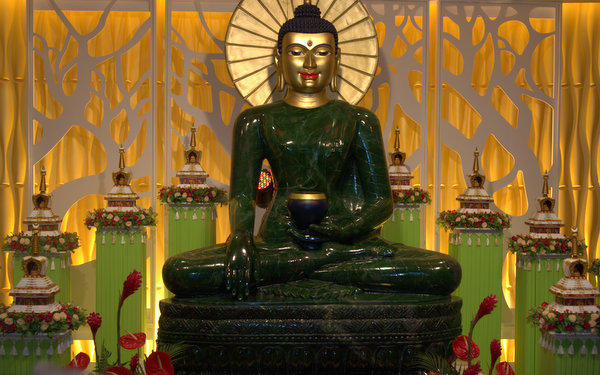
Jade Buddha for Universal Peace, Kuala Lumpur, Malaysia, March 2013. Photo by Bill Kane.
In May 2007, Lama Zopa Rinpoche requested that students recite the Golden Light Sutra as much as possible for world peace. Rinpoche said:
Anybody who wants peace in the world should read the Golden Light Sutra (Ser.ö dam.päi do wang.gyi gyälpo). This is a very important practice to stop violence and wars in the world. The Golden Light Sutra is one of the most beneficial ways to bring peace. This is something that everyone can do, no matter how busy you are, even if you can read one page a day, or a few lines and in this way continually read the Golden Light Sutra.
The holy Golden Light Sutra is the king of the sutras. It is extremely powerful and fulfills all one’s wishes, as well as bringing peace and happiness for all sentient beings, up to enlightenment. It is also extremely powerful for world peace, for your own protection and for the protection of the country and the world. Also, it has great healing power for people in the country.
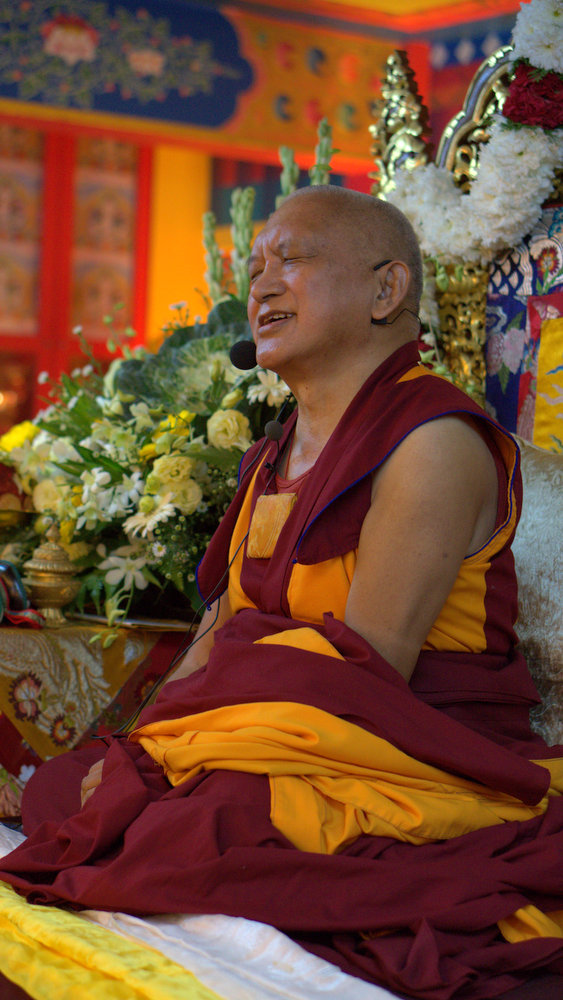
Lama Zopa Rinpoche teaching at Losang Dragpa Centre, Malaysia, March 2013. Photo by Bill Kane.
Even before making this request, Rinpoche had asked FPMT students to recite the Golden Light Sutra. Ven. Lhundup Nyingje (Paula Chichester) was so inspired to recite the sutra that she organized a campaign amongst all the FPMT centers to recite the sutra as many times as possible in October 2006, leading up to congressional elections in the United States, which she wrote about for Mandala. Ven. Nyingje writes:
It is wonderful to sit with a group of six to ten people and recite parts of the sutra together. You can divide up the numbers of the pages of the sutra by the number of people present. After everyone has their assigned pages, someone in the group can lead a meditation that includes refuge and an inspiring bodhichitta motivation. Add to that a motivation for global kindness and wisdom that will produce leaders who will legislate for world peace, sane environmental policies, help for the sick and the poor, and other beneficial ends. When everyone recites their pages simultaneously, the cacophony of sounds mixed with the joy and amazement that comes from reading such words is a powerful experience.
FPMT Education Services has a webpage dedicated to the Golden Light Sutra where one can read more about the benefits of reciting the sutra, download the entire text of the Golden Light Sutra in 14 different languages, see how many recitations of the Golden Light Sutra have been reported over the last five years, download audio of the Golden Light Sutra being recited by Kirti Tsenshab Rinpoche and much more.
The Lama Yeshe Wisdom Archive also has audio of commentaries by Lama Zopa Rinpoche on the Golden Light Sutra from New York in September 2007 and Portland, Oregon, in November 2007.
For information on the Jade Buddha for Universal Peace, please visit www.jadebuddha.org.au.
- Tagged: golden light sutra, mandala, world peace
- 0
18
Seeing the True Beauty of Inner Potential

Lama Thubten Yeshe
During a five-day meditation course in 1975 held at Dromana, near Melbourne, Australia, FPMT founder Lama Thubten Yeshe discussed our warped understanding of our bodies. During the talk, Lama Yeshe encourages students to closely examine the ego’s superficial projections. He begins the teaching by examining our ideas about beauty:
We would all like to have beautiful bodies; our ego wants our body to be beautiful. But at the same time, our attachment – sneaky, grasping attachment – makes us eat more than our body requires. Thus our body becomes fat and heavy. So all the worry and bother that we experience as a result comes from these two departments, ego and attachment. This is just a simple example, common in many of our lives.
Check it out for yourself. Perhaps your body needs very little food, but your grasping attachment to over-eating makes you fat, heavy and uncomfortable. At the same time, you also worry about losing your beauty; these two things are in conflict. So which do you choose, the ego’s wish for a beautiful body or the attachment to eating food? Look into your mind; find the one you cling to most. One mind is there, grasping at beauty; the other is there too, knowing consciously that if you eat too much you’ll get fat and destroy whatever beauty you have. Still, you can’t stop eating; these two minds agitate you, give you a psychological beating. But despite their constantly mashing you, you keep saying “Yes, yes, yes….” It’s funny.
You can read the entire teaching “Beauty Is in the ‘I’ of the Beholder” from Mandala November-December 1997 in Mandala’s online archive.
16
Medicine Buddha Prayers for Those Suffering, Injured and Killed
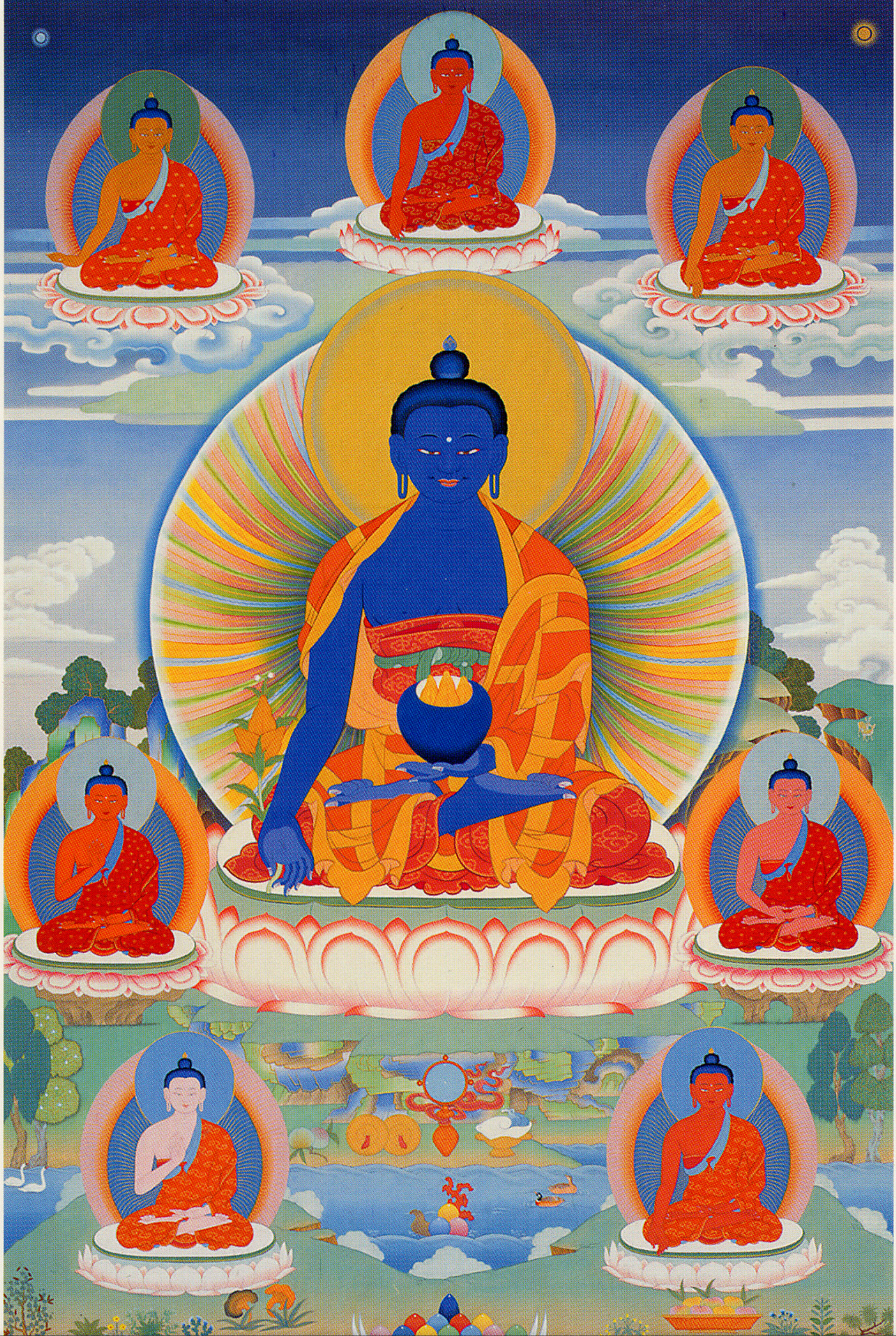
Medicine Buddha thangka by Peter Iseli
From FPMT International Office and Mandala:
Our hearts and prayers go out to the victims of the tragedy that occurred on Monday, April 15, at the Boston Marathon.
Lama Zopa Rinpoche always advises to make strong prayers to Medicine Buddha for anyone who is dying, sick, injured, or who has already died from the violence that occurred in Boston and elsewhere.
Please make prayers for the sick and injured to recover. For those who lost their lives in the tragedy, please make prayers for their families and survivors to be blessed by and receive healing from Medicine Buddha. Also, please make prayers for those who have died to be born in a pure land and become enlightened, or to receive a perfect human body, meet with the precious Dharma, receive teachings and to achieve enlightenment as quickly as possible.
Medicine Buddha practice can be done for anyone who is sick, dying or even who has already died. Reciting the mantra of Medicine Buddha is one of the best practices we can do at this time.
The mantra of Medicine Buddha is:
TADYATA OM BHEKHANDZYE BHEKHANDZYE MAHA BHEKHANDZYE (BHEKHANDZYE) RAJA SAMUDGATE SVAHA
You can download a PDF of the Medicine Buddha practice “Wish-Fulfilling Jewel.”
- Tagged: land of medicine buddha, mandala, terrorism, violence
- 0
12
Tenzin Ösel Hita on ‘How to Understand Our Reality from the Universal Point of View’
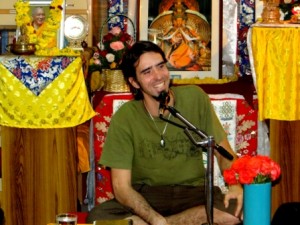
Tenzin Ösel Hita teaching at Choe Khor Sum Ling Study Group, Bangalore, India, February 2013.
Tenzin Ösel Hita’s talk on “How to Understand Our Reality from the Universal Point of View” on February 9, 2013, was a major event at Choe Khor Sum Ling Study Group (CKSL) in Bangalore, India. The audience was not at all discouraged by waiting for one-and-a-half hours while Ösel was battling the bad Bangalore traffic. Ösel, the recognized reincarnation of FPMT founder Lama Yeshe, picked his talk up right from that point, focusing on traffic jams and other stressful features of city life that turn our everyday existence into a real test of endurance.
“To deal with all that, we have to work with the state of our mind. It’s essential to understand how our mind functions. Reality is, after all, created by the mind. Bangalore, the universe, and everything that is man-made – it all starts with a thought. Without that thought at the beginning, nothing is possible. That’s why it is so important to observe our thoughts,” he taught.
Read more …
From Mandala July-September 2013
10
How Kirti Tsenshab Rinpoche Blessed the World’s Waterways

Kirti Tsenshab Rinpoche with Alak Rinpoche in Antarctica, 2006
In the last year of his life, Kirti Tsenshab Rinpoche, who passed away in December 2006, was able to fulfill a long-held wish to visit Antarctica. During the extraordinary journey, Kirti Tsensab Rinpoche and his attendant, Alak Rinpoche, offered countless pujas and blessings.
Bruce Farley described the amazing Antarctic adventure in Mandala October-November 2006:
Why Antarctica? According to Kirti Tsenshab Rinpoche, because it is the most southern pole of the earth, many water currents gather and disperse from Antarctica, finding their way all over the planet. Likewise, many of the world’s weather patterns stem from the southern ocean. Ninety percent of the world’s ice and seventy percent of the world’s fresh water are found in Antarctica. Rinpoche’s wish was to bless these currents with holy water containing blessings from His Holiness the Dalai Lama, as well as water gathered from all the oceans of the world, and from lakes, rivers, etc., visited by Rinpoche over many years. The blessed water also contained sand from many mandalas performed by His Holiness the Dalai Lama, and by Kirti Tsenshab Rinpoche. It is believed that this mixing and unification of water coming from different origins, along with the power of various pujas, can bring about pacification of extreme weather patterns and stabilize and harmonize weather in any place, especially if the weather patterns are disturbed.
Secondly, Rinpoche wished to place a specially-made stone Buddha, carved in Bodhgaya, India, on the Antarctic ocean floor. (This was also done at the tip of South Africa where the Atlantic and Indian Oceans meet, and in Tasman Bay, Nelson, New Zealand.) … Rinpoche says that for as long as these holy forms remain in the water they radiate the blessings of the Buddha. The water that comes in contact with these holy forms becomes blessed, and carries the blessing around the whole of the ocean. Subsequently, whatever comes in contact with that blessed water receives the blessing as well.
Thirdly, [Kirti Tsenshab Rinpoche and Alak Rinpoche] wished to visit Antarctica in order to perform pujas on the actual Antarctic continent.
You can read Bruce’s complete article “Blessing the World’s Waterways” from Mandala October-November 2006 in Mandala’s online archive.
If you like what you read on Mandala, consider becoming a Friend of FPMT, which supports our work.
FPMT touring teacher Geshe Thubten Soepa is well known for his advocacy of vegetarianism and is a familiar teacher to students at Land of Compassion and Wisdom in Austin, Texas, United States, and Aryatara Institut in Germany.
In Mandala’s April-June 2013 online edition, we feature an video interview with Geshe Thubten Soepa in which he shares a bit about his background and his deep interest in animal welfare.
If you like what you read on Mandala, consider becoming a Friend of FPMT, which supports our work. Friends of FPMT at the Basic level and higher receive the print magazine Mandala, delivered quarterly to their homes.
8
Lama Zopa Rinpoche’s Journey to Sikkim

Lama Zopa Rinpoche and students at the large statue of Padmasambhava in Sikkim, India, 2006
Continuing from our latest issue of Mandala’s exploration of pilgrimage, we’re sharing a story, newly added to our archive, that describes a memorable journey with Lama Zopa Rinpoche to a recently created holy site.
In 2006, Rinpoche traveled to Sikkim to visit the world’s largest statue of Padmasambhava [Guru Rinpoche], which was publicly unveiled in 2004 and stands 135 feet (41 meters) tall. Rinpoche was joined by Cherok Lama and several others, including Lillian Too, who at the time was director of Losang Dragpa Centre in Malaysia. She shared an inspiring account of the journey with Mandala.
Lillian wrote:
After lunch that day, we climb to Samdruptse to view the brand new statue of Padmasambhava. This is the highlight of our visit. It is Guru Rinpoche who caused us to come to Sikkim and each one on the journey has a special affinity with Padmasambhava.
The approach to the statue is from the back. A line of people and monks are waiting to greet Rinpoche and to offer khata. I never cease to be amazed at how local people can always smell the presence of Rinpoche wherever he goes. There are also monks from the Sera Je monastery in Gangtok who have motored down to receive Rinpoche. Now they lead Rinpoche up the steps to the front of the statue.
Oh, my! The statue is so awesome.
You can read Lillian’s complete account of the “Journey to Sikkim” from Mandala August-September 2006 as a PDF.
- Tagged: lama zopa rinpoche, lillian too, mandala, padmasambhava, pilgrimage, sikkim
- 0
5
Scott Snibbe on Dharma, Technology and Art
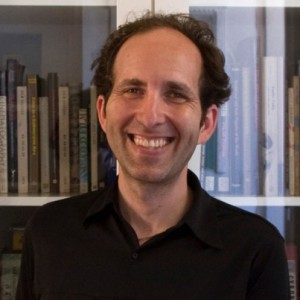
Scott Snibbe
Software developer, digital artist and Dharma student Scott Snibbe just wrapped up leading a month-long online retreat at Vajrapani Institute focused on the eight worldly dharmas. Before the retreat, he spoke with Mandala in an extensive interview ranging from ideas about new avenues for technology to share and spread Dharma to growing up in an artistic Christian Scientist household to his passion for exploring the artistic potential of digital light, motion and color.
“One of the things I really believe that many people thought was contradictory was that computers could be a way to get you closer to nature,” Snibbe said. “Most of those programs that I wrote … are ways of giving people a feeling of nature, something that is like nature, but doesn’t actually exist in our universe. [It’s] the same kind of feeling as sitting on a beach looking at the ocean or watching a sunset, watching ripples in water. There is an essence to nature that is mathematical and algorithmic and also has this infinite range. There is way more of nature, you could think, than what exists in our universe. That is what these programs do. They can take people into that same mental state that nature can take you to. Ven. René [Feusi] once told me a reason why nature is so positive for people. He said, ‘There are no objects of attachment out of nature.’”

Screenshot from “Glass Machine” on REWORK
One of Snibbe’s recent creations is the app album REWORK, which was produced in collaboration with Beck and features remixes of Phillip Glass’ music. “There is one part of the app that lets you make your own music called the ‘Glass Machine,’” Snibbe explained. “It takes the way Philip Glass makes music by putting these two arpeggios against each other and making them play tightly together. You can make these just by pushing little disks around on spidery turntables.”
You can read the complete interview as part of Mandala April-June 2013’s online content.
Scott’s March retreat at Vajrapani was so well received that another combined retreat and online program is already in the works for July 2013. Stay tuned to Vajrapani’s website for more information to come.
If you like what you read on Mandala, consider becoming a Friend of FPMT, which supports our work. Friends of FPMT at the Basic level and higher receive the print magazine Mandala, delivered quarterly to their homes.
3
Eco Ethics: Interdependence and Compassion
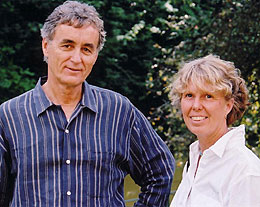
Elaine Brook (right) with physicist Fritjof Capra, adviser on ecological issues
“Now that environmental issues, and climate change in particular, have become headlines in the mainstream media, the question that arises for us all is how to address issues of universal responsibility,” wrote author and photographer Elaine Brooks in Mandala October-November 2006. “For Buddhists, the question is not only ‘Is this something that is relevant to our practice?’ but also, ‘If we are following a practice focused on interdependence and compassion, should we be taking a lead, setting an example, or simply waiting for politicians or market forces to push us into action?’”
In her Mandala article, Brooks described how an understanding of universal responsibility and interdependence can change our everyday actions. “Many Buddhists today feel that the core principle of compassion should be more than thoughts, feelings, prayers, meditations, and being kind to the people we meet: It is an ethic that needs to be extended to our ordinary, everyday habits – how we use energy, transport, food, clothing, and so on,” she wrote.
Brooks shared her two favorite quotes from His Holiness the Dalai Lama:
“Buddhism can be explained in terms of two points: first, a deep understanding of the interdependence of all things and events and second, the practice of non-harming, of helping others, that is based on the understanding of the first.”
“Meditation is something that needs to be done twenty-four hours of the day.”
“These few short sentences open a door to a way of life based on constant mindfulness of the interpenetrating chains of events which ripple outwards from our every action and non-action,” she wrote.
Read more from Elaine Brooks’ article “Eco Ethics: Engaging in the Practice of Compassion” from Mandala October-November 2006.
2
FPMT Annual Review 2012: Nothing More Important than Helping Others
“I really am so happy about the benefits that we bring to others,” Lama Zopa Rinpoche wrote in the opening to FPMT Annual Review 2012: Nothing More Important than Helping Others. Rinpoche continues by thanking the thousands of people who help FPMT and FPMT International Office:
All this benefit is due to your kindness and prayers in the past and the present and because of that it will also be beneficial in the future. This is like a wish-fulfilling jewel removing the darkness of the world, benefiting those that need help. … From my heart, I thank all of you for what you have done in the past and present and for what you will do in the future. Please continue in the future, if possible even better, with your wisdom and compassion.
In addition to Rinpoche’s introductory letter, the FPMT Annual Review 2012 also contains personal letters from Tenzin Ösel Hita (board member and recognized reincarnation of FPMT’s founder, Lama Yeshe) and Ven. Roger Kunsang (president and CEO) to FPMT supporters and students.
The recently published report, created by FPMT International Office, shares its accomplishments over the last year and features beautiful photos, inspiring quotes, and important information about the organization’s financial and structural health. If you are curious about how International Office supports Lama Zopa Rinpoche’s overall spiritual vision, please read over this review, available to read online or as a downloadable PDF.
With more than 160 centers, projects and services around the globe, there is always news on FPMT activities, teachers and events. Mandala hopes to share as many of these timely stories as possible. If you have news you would like to share, please let us know.
- Tagged: annual review, fpmt international office, mandala
- 0
1
Lama Zopa Rinpoche on Untimely Death
Lama Zopa Rinpoche’s Online Advice Book is a collection of a wide range of advices given by Rinpoche to specific students in responses to letters and requests. The Lama Yeshe Wisdom Archive compiles and edits these pieces, adding new ones each month. Mandala offers these excerpts hoping to benefit students and to raise awareness of the Online Advice Book.
From the page “Death of a Loved One,” Lama Zopa Rinpoche writes to a student whose 13-year-old daughter unexpectedly died in bed:
My way of thinking is – so many people in this world went to bed last night but in the morning did not get up, they died. The cause can be natural, or a coma, also unknown, etc. Death does not come when it is expected. Many times, the doctors do not know the cause of death. Many people die who are healthy, who are young, and it doesn’t make sense. Many people who are in perfect health suddenly die. So many people in this world go to bed and in the morning, they are dead, without any pain, just passing away in their sleep, their breath stops. This happens so many times. Actually, you will find it is not unusual for this to happen in this world.
You don’t need to feel superstitious regarding this. This is karma. How long one lives and having an untimely death is caused by karma. Death is definite, it’s not like death won’t happen. When someone dies is not fixed according to one’s age. It’s not like when one is 100 or 50 then one dies. The time of death is not fixed. Whether one has a long or short life all depends on past karma. …
You can read Rinpoche’s complete response to this letter, called “The Cause of a Long Life,” on the “Death of a Loved One” page, part of Lama Zopa Rinpoche’s Online Advice Book.
- Tagged: death, lama zopa rinpoche online advice book, mandala
- 0
29
Sarah Shifferd’s ‘Songs and Mental States’

“I Love My Music!” Photo by Shiv Shankar Menon Palat; Flickr Creative Commons attribution.
Songs. We love songs. And songs are everywhere. They’re played in stores, restaurants, coffeehouses, as soundtracks to movies and TV shows. They’re sung by street musicians and sent to us by friends. We listen as we drive and clean and work and dance. And when you have a mind like mine – conditioned by decades of training in words and music – a single song can stick for a long, long time.
Actually, songs stick longer than we think. If the Buddha’s teachings are true, then everything we put into our minds creates an imprint that shapes the way we think and act, both now and in the future. The words of a song can calm and soothe us, lift us to a higher state of consciousness, rile us up into excitement, or throw us into attachment or despair. The more we listen to a song or songs like it, the more those mental states become ingrained. We begin to believe them, or rather, we reinforce mental states and beliefs from this and previous lifetimes. They become part of who we are, part of how we interact with the world. As Mahatma Gandhi said, “Your beliefs become your thoughts; your thoughts become your words; your words become your actions; your actions become your habits; your habits become your values; your values become your destiny….”
Find columnist Sarah Shifferd’s playlist of songs that “express some positive message or Dharma truth” on fpmt.org/mandala/ …
From Mandala April-June 2013
- Home
- News/Media
- Study & Practice
- About FPMT Education Services
- Latest News
- Programs
- New to Buddhism?
- Buddhist Mind Science: Activating Your Potential
- Heart Advice for Death and Dying
- Discovering Buddhism
- Living in the Path
- Exploring Buddhism
- FPMT Basic Program
- FPMT Masters Program
- FPMT In-Depth Meditation Training
- Maitripa College
- Lotsawa Rinchen Zangpo Translator Program
- Universal Education for Compassion & Wisdom
- Online Learning Center
- Prayers & Practice Materials
- Overview of Prayers & Practices
- Full Catalogue of Prayers & Practice Materials
- Explore Popular Topics
- Benefiting Animals
- Chenrezig Resources
- Death & Dying Resources
- Lama Chopa (Guru Puja)
- Lama Zopa Rinpoche: Compendium of Precious Instructions
- Lama Zopa Rinpoche: Life Practice Advice
- Lama Zopa Rinpoche Practice Series
- Lamrim Resources
- Mantras
- Prayer Book Updates
- Purification Practices
- Sutras
- Thought Transformation (Lojong)
- Audio Materials
- Dharma Dates – Tibetan Calendar
- Translation Services
- Publishing Services
- Teachings and Advice
- Find Teachings and Advice
- Lama Zopa Rinpoche Advice Page
- Lama Zopa Rinpoche: Compendium of Precious Instructions
- Lama Zopa Rinpoche Video Teachings
- ༧སྐྱབས་རྗེ་བཟོད་པ་རིན་པོ་ཆེ་མཆོག་ནས་སྩལ་བའི་བཀའ་སློབ་བརྙན་འཕྲིན།
- Podcasts
- Lama Yeshe Wisdom Archive
- Buddhism FAQ
- Dharma for Young People
- Resources on Holy Objects
- Ways to Offer Support
- Centers
- Teachers
- Projects
- Charitable Projects
- Make a Donation
- Applying for Grants
- News about Projects
- Other Projects within FPMT
- Support International Office
- Projects Photo Galleries
- Give Where Most Needed
- FPMT
- Shop
Subscribe to FPMT News
Translate*
*powered by Google TranslateTranslation of pages on fpmt.org is performed by Google Translate, a third party service which FPMT has no control over. The service provides automated computer translations that are only an approximation of the websites' original content. The translations should not be considered exact and only used as a rough guide.Real happiness in life starts when you begin to cherish others.







